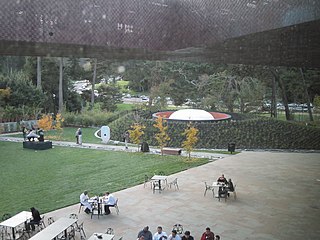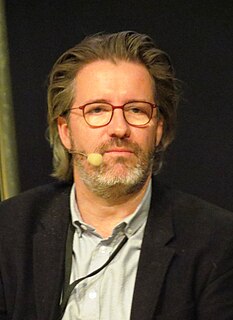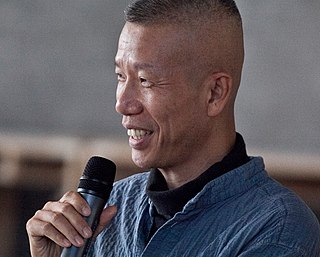
Louis Comfort Tiffany was an American artist and designer who worked in the decorative arts and is best known for his work in stained glass. He is the American artist most associated with the Art Nouveau and Aesthetic movements. He was affiliated with a prestigious collaborative of designers known as the Associated Artists, which included Lockwood de Forest, Candace Wheeler, and Samuel Colman. Tiffany designed stained glass windows and lamps, glass mosaics, blown glass, ceramics, jewellery, enamels, and metalwork. He was the first design director at his family company, Tiffany & Co., founded by his father Charles Lewis Tiffany.

Douglas Gordon is a Scottish artist. He won the Turner Prize in 1996, the Premio 2000 at the 47th Venice Biennale in 1997 and the Hugo Boss Prize in 1998. He lives and works in Berlin, Germany.

Dan Flavin was an American minimalist artist famous for creating sculptural objects and installations from commercially available fluorescent light fixtures.

Josef Albers was a German-born artist and educator. He taught at the Bauhaus and Black Mountain College, headed Yale University's department of design, and is considered one of the most influential teachers of the visual arts in the twentieth century.

Robert W. Irwin is an American installation artist who has explored perception and the conditional in art, often through site-specific, architectural interventions that alter the physical, sensory and temporal experience of space.

Anselm Kiefer is a German painter and sculptor. He studied with Peter Dreher and Horst Antes at the end of the 1960s. His works incorporate materials such as straw, ash, clay, lead, and shellac. The poems of Paul Celan have played a role in developing Kiefer's themes of German history and the horror of the Holocaust, as have the spiritual concepts of Kabbalah.

James Turrell is an American artist known for his work within the Light and Space movement. Much of Turrell's career has been devoted to a still-unfinished work, Roden Crater, a natural cinder cone crater located outside Flagstaff, Arizona, that he is turning into a massive naked-eye observatory; and for his series of skyspaces, enclosed spaces that frame the sky.

Olafur Eliasson is an Icelandic–Danish artist known for sculptured and large-scale installation art employing elemental materials such as light, water, and air temperature to enhance the viewer’s experience. In 1995 he established Studio Olafur Eliasson in Berlin, a laboratory for spatial research. In 2014, Eliasson and his long-time collaborator, German architect Sebastian Behmann founded Studio Other Spaces, an office for architecture and art. Olafur represented Denmark at the 50th Venice Biennale in 2003 and later that year installed The Weather Project, which has been described as "a milestone in contemporary art", in the Turbine Hall of Tate Modern, London.

Qiu Zhijie is a contemporary Chinese artist who works primarily in video and photography. Overall, Qiu's work suggests the struggle between the forces of destiny and self-assertion. Other common themes are social fragmentation and transience.

Robert Whitman is an American artist best known for his seminal theater pieces of the early 1960s combining visual and sound images, actors, film, slides, and evocative props in environments of his own making. Since the late 1960s he has worked with new technologies, and his most recent work incorporates cellphones.

Cai Guo-Qiang is a Chinese artist who currently lives and works in New York City and New Jersey.

Brian Clarke is a British painter, architectural artist and printmaker, known for his large-scale stained glass and mosaic projects, symbolist paintings, set designs, and collaborations with major figures in Modern and contemporary architecture.

James Luna was a Payómkawichum, Ipi, and Mexican-American performance artist, photographer and multimedia installation artist. His work is best known for challenging the ways in which conventional museum exhibitions depict Native Americans. With recurring themes of multiculturalism, alcoholism, and colonialism, his work was often comedic and theatrical in nature. In 2017 he was awarded a Guggenheim Fellowship.

Liza Lou is an American visual artist. She is best known for producing large scale sculpture using glass beads. Lou ran a studio in Durban, South Africa from 2005 to 2014. She currently has a nomadic practice, working mostly outdoors in the Mojave Desert in southern California. Lou's work is grounded in domestic craft and intersects with the larger social economy.

Light and Space denotes a loosely affiliated art movement related to op art, minimalism and geometric abstraction originating in Southern California in the 1960s and influenced by John McLaughlin. It was characterized by a focus on perceptual phenomena, such as light, volume and scale, and the use of materials such as glass, neon, fluorescent lights, resin and cast acrylic, often forming installations conditioned by the work's surroundings. Whether by directing the flow of natural light, embedding artificial light within objects or architecture, or by playing with light through the use of transparent, translucent or reflective materials, Light and Space artists made the spectator’s experience of light and other sensory phenomena under specific conditions the focus of their work. They were incorporating into their work the latest technologies of the Southern California-based engineering and aerospace industries to their develop sensuous, light-filled objects. Turrell, who has spread the movement worldwide, summed up its philosophy in saying, "We eat light, drink it in through our skins."
Alex Brewer, also known as HENSE, is an American contemporary artist, best known for his dynamic, vivid and colorful abstract paintings and monumental wall pieces. He has been active since the 1990s. In 2002 he began accepting commissions for artwork and over the course of the last decade has established a solid reputation as a commissioned artist, having appeared in several solo and group shows.

Eve Andree Laramee is an installation artist whose works explores four primary themes: legacy of the atomic age, history of science, environment and ecology, social conditions. Her interdisciplinary artworks operate at the confluence of art and science. She is currently professor and chair of the Department of Art and Art History at Pace University. Laramee currently lives in Brooklyn, New York, and Santa Fe, New Mexico. She is also the founder and director of ART/MEDIA for a Nuclear Free Future.
David Wiseman is an American artist and designer whose work is notable for its intricate craftsmanship and dialogue with traditional decorative arts. "Celebrated for groundbreaking sculpture, furniture, lighting and site-specific installations that combine natural forms with classical craftsmanship, David Wiseman is a creative tour de force." His work spans from bronze filagree patterned screens and gates to bronze and terrazzo furniture, from animal sculptures to porcelain vases.
Jennifer B. Thoreson, formerly Jennifer B. Hudson, is a contemporary visual artist and photographer. She incorporates mechanical and natural elements in sculpture, installation, costuming, makeup, and digital editing to create hauntingly beautiful images that address faith, spirituality, and the acceptance of one's self.
Kayne Griffin is a contemporary art gallery based in Los Angeles. The gallery represents and works with artists such as James Turrell, Mary Corse, David Lynch, Tomoharu Murakami, Peter Shire, Rosha Yaghmai, Jiro Takamatsu, Anthony Hernandez, Mika Tajima, Mary Obering, Liza Ryan, Hank Willis Thomas, Llyn Foulkes and Beverly Pepper.
















